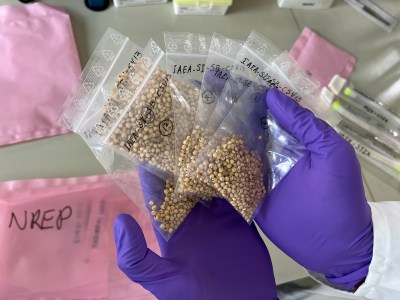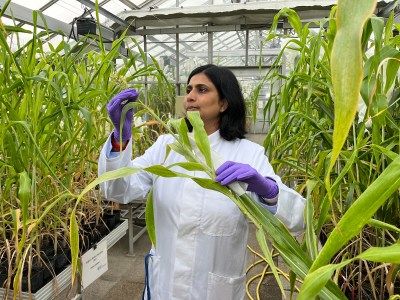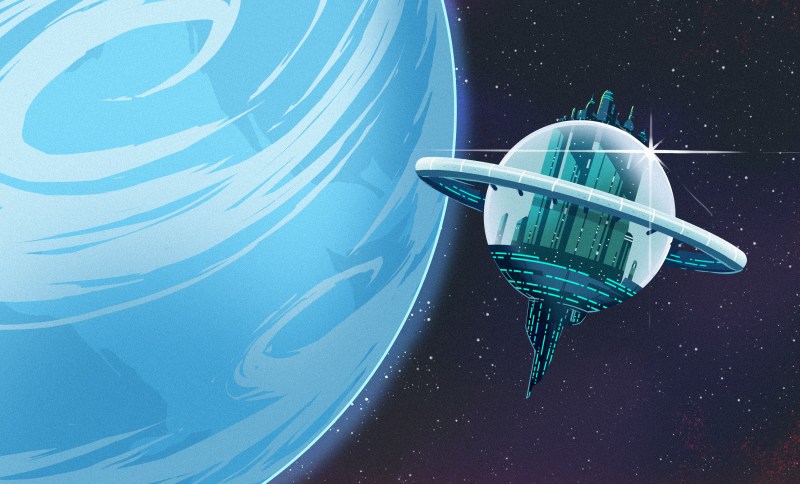Humans have forever been using all manner of techniques to better secure the food we need to sustain our lives. The practice of agriculture is intimately tied to the development of society, while techniques like selective breeding and animal husbandry have seen our plants and livestock deliver greater and more nourishing bounty as the millennia have gone by. More recently, more direct tools of genetic engineering have risen to prominence, further allowing us to tinker with our crops to make them do more of what we want.
Recently, however, scientists have been pursuing a bold new technique. Researchers have explored using radiation from space to potentially create greater crops to feed more of us than ever.
“Cosmic Crops”
Most recently, an effort at “space mutagenesis” has been spearheaded by the International Atomic Energy Agency, a body which has been rather more notable for other works of late. In partnership with the UN’s Food and Agriculture Organization (FAO), it has been examining the effects that the space-based environment might have on seeds. Ideally, these effects would be positive, producing hardier crops with greater yields for the benefit of humanity.

The concept is simple enough—put a bunch of seeds on the International Space Station (ISS), and see what happens. Specifically, researchers placed half the seeds outside the ISS, where they would be exposed to extreme cold and maximum doses of cosmic radiation. The other half were left inside the station as a control, where they would experience microgravity but otherwise be safe from temperature and radiation extremes. The hope was that the radiation may cause some random but beneficial mutations in the seed’s genetics which provide better crops for use on Earth.

Two types of seeds were sent up for the first trial by the IAEA and UN—sorghum, a nutrient-filled cereal grain, and arabidopsis, a fast-growing cress. After their flight on the ISS, they were returned to Earth to be germinated, grown, and examined for desirable traits. Of course, DNA sequencing was also on the table, to compare mutations generated in space with seeds kept inside the ISS and those irradiated under laboratory conditions.
The only thing missing from the IAEA’s experiment? A research paper. The seeds returned from space in April 2023, and were sent to the Plant Breeding and Genetics Laboratory in Seibersdorf, Austria soon after. We’ve seen pictures of the plants that sprouted from the seeds in space, but researchers are yet to publish full results or findings from the project.
Proven Benefits
It might sound like an oddball idea, particularly given the results from the IAEA’s project are yet to be delivered. However, space mutagenesis has been tried and tested to a greater degree than you might think. Chinese scientists have been experimenting with the technique of space mutagenesis for over 30 years, finding that it often delivers more beneficial mutations compared to using gamma rays in terrestrial labs.
Chinese efforts have seen many thousands of seeds irradiated via satellites and space stations, including a trip around the moon on the Chang’e-5 mission. Having been exposed to space radiation for anywhere from days to months, the seeds have returned to Earth and been planted and examined for beneficial mutations. While not every seed comes back better than before, some show rare mutations that offer breakthrough benefits in yield, drought resistance, fruit size, or temperature hardiness. These crops can then be bred further to refine the gains. Chinese efforts have experimented with everything from cotton to tomatoes, watermelons and corn, beyond others. A particular success story was Yujiao 1 – a sweet pepper variety released in 1990 boasting better fruit and resistance to disease, along with 16.4% higher yield than some comparable varieties.

The results of space mutagenesis are tracked very carefully, both by researchers involved and wider authorities. Notably, the IAEA maintains a Mutant Variety Database for plants that have been modified either by space-based radiation or a variety of other physical or chemical methods. This is important, and not only for reaping the benefits from mutagenic organisms. It’s also important to help researchers understand the mechanisms involved, and to help make sure that the risk of any negative traits breaking out into broader wild plant populations are mitigated.
Ultimately, space mutagenesis is just another tool in the toolbox for scientists looking to improve crops. It’s far from cheap to send seeds to space, let alone to do the research to weed out those with beneficial mutations from the rest. Still, the benefits on offer can be huge when scaled to the size of modern agriculture, so the work will go on regardless. It’s just another way to get more, something humans can never quite get enough of.
















If a useful mutation is found by whatever means, great. This seems like a lot of work to tweak the existing throw-them-against-a-wall method using powerful mutagenic chemicals and radioisotopes.
On the bright side we just may get Swamp Thing.
After reading the linked BBC article I was thinking that the top priority of this research should be recreating the…less herbicidal radiation conditions that occur naturally in space inside earth-based irradition chambers. This is showing us that the traditional earth-based methods have been overcooking the plants.
On the other hand, new world screw fly has been eradicated from North America due to accidental discovery with male fly and radiation. Screw flies (the new world side) are nasty in that they lay eggs in open wounds and maggots will eat the victim alive. It costs a lot to treat cattle and people to remove eggs and maggots. The irradiated male flies compete for female but they can’t “plant a seed” and the female ends up having empty eggs and the local population collapses.
Right now there are still some in the South America, the cut off point is at the border between Panama and Colombia. Considerable investment would be required in expanding the breeding of infertile screw flies and scattering them across South America, and those countries aren’t very well off.
Martian Grow?
Said company sent cannabis seeds to space recently, on an ultimately doomed flight, with the expectation of ‘positive’ mutagenic results. – Prolly the wrong crowd.
People will go to any length, even obviously stupid ones, to try to make it seem that doing things in space might be useful.
If you want to irradiate a freakin’ seed, just irradiate the seed.
Data or it didn’t happen.
TCM doesn’t work either.
Given the variety of novel conditions in space it is quite plausible these seeds gain some further benefit from just nuclear gardening. If those benefits are actually genetic mutations rather than functional on that seed only – the way cold plasma treatments seem to work (though last I saw research into that was also in earlier stages).
That said I agree scepticism is called for without evidence (especially considering the nation in question – some good people and solid work and lots of PR spin for international prestige).
The only novel condition is space that isn’t replicated on earth is extended free-fall.
The highest energy cosmic rays have about 10 million times the LHC’s energy.
And they enter the earth’s atmosphere and reach the ground too.
Many things that would be true for space prepared samples COULD be replicated on Earth if you tried hard enough, but in practice they are not. And for some of them it is still going to be easier and cheaper to shoot the sample into space I expect expensive as that is than try to replicate it in the lab – you have all the Earth’s Magnetic field effects, the fluctuations in ‘gravity’ in both force and direction over time, the sealed self contained environment made of the lightest materials rated for space that can do the job etc.
And until the research is done there are so many variables that you can’t know which ones are the right ones, or if its a combination of any number of factors. (assuming of course there is actually any further benefit to ‘Outer Atmosphere Gardening’ over the Earth based Radioactive Gardening.
“…Chinese scientists have been experimenting with the technique of space mutagenesis for over 30 years, finding that it often delivers more beneficial mutations compared to using gamma rays in terrestrial labs….”
Something about this doesn’t smell right.
The corn genome, as an example, has something like two billion base-pairs. Why would anyone expect that irradiating that plant (damaging the DNA in random ways) would somehow “enhance” it? Look at it this way:
Imagine instead a binary executable with two billion bytes worth of data and CPU instructions… Along comes a guy who thinks that a plausible technique for “upgrading” that software is to randomly flip bytes throughout the body of the code.
I suppose–technically–there exists the non-zero possibility that a sufficiently-long sequence of “random” byte flips could convert “Doom”into “Grand Theft Auto.” However, the odds of this are so small that no rational person would entertain such a notion. Worse, there are likely to be long spans during the software “mutuation” process where the program functioned neither as some version of Doom, nor as some version of Grand Theft Auto, and was in fact operationally nonviable. Living things don’t have that luxury because, by definition, a dead creature doesn’t produce offspring that could “benefit” from further random changes.
Maybe the perceived “improvements” in irradiated crops has nothing to do with mutation at all, but is instead the result of the plant’s existing internal response to environmental stress/damage.
A decade or more ago, Scientific American published an article about a researcher who accidentally discovered that many plants grow larger, healthier, and show greater reproductive activity when poisoned with diluted herbicides (chemicals that in normal concentrations would kill the plant, outright.) Apparently similar effects are seen in animals.
Was it Nietzsche who said: “…that which doesn’t kill me only makes me stronger…”?
Radioactive gardening has been a thing for a long time, and it does work. That random flipping of bits as you put it is sort of accurate, but with plants in question usually being fairly rapid in growth and breeding you run thousands of samples many of which won’t have transmuted Doom into GTA, most of which are probably useless even, but every now and then you’ll get a success.
Also worth remembering that many genes are dormant and actually pretty irrelevant because of it.
The herbicide 2,4-D works by accelerating growth more than the plant can maintain. It makes sense that a minuscule dose would just cause faster growth without damage.
I’m really surprised to hear there’s much difference in radiation dose rate inside and outside the (very thin) space station walls. I’d expect to see a difference in type, with the particle dose rate decreased, but the low energy gammas increased (due to secondaries from the high energy particle impacts), with the overall dose deposited to organics pretty much being in the same ballpark inside and out.
At sea level we benefit from living underneath ten tonnes per square meter of shielding material. Decrease that even by half (climb a mountain, take an airplane flight) yields a dramatic increase in dose rate. The puny amount of shielding provided by the space station walls is tiny in comparison.
How would such an experiment disambiguate (attribute) observed changes to radiation-induced changes vs. extreme and rapid temperature cycling? There must be more to the design of this experiment than is apparent from the fluffy press release.
I dont know the exact specification of the spaceside storage space, but given the discrepancy between out of/in station seeds, one can assume that at least the beta radiation is depositing significant doses on the outside seeds. Then again, could just be the vacuum.
What is old is new again. Atomic gardening is a technique dating back from at least the 50s, done here on earth, in a controlled and reproducible way. Way cheaper then sending anything up there, and you have full control, except of course the genetic alterations which are random. This article does not even mention it, and presents the technique as new. Can´t research a minimum about the topic before throwing an article ?
Reminds me of the Moon Trees https://en.wikipedia.org/wiki/Moon_tree
I love atomic gardening!
Although, I would be curious how much the data supports cosmic rays being better than regular atomic gardening. It would be kind of sad if the real difference was radiation dose or the ambient temperature.
Fingers crossed that the new research will be published and actually address this question.
What I was thinking too, be a lot easier to do on the ground with radiation. Or just make changes with CRISPR but you know, genetic engineering is bad.
CRISPR would be far more efficient, but irradiating rapeseed to make canola means they can sell it at a premium as “non-gmo” as the “modification” wasn’t done (directly) by people.
Maybe it really was crisper.
To make changes selectively you actually have to know what you want and what it will do. Some things you can have a good idea of the results, but without completely comprehending the entire rulebook for the building blocks to be able to know the results many changes that could be great you’d never try.
Random mutations being studied gives some of that understanding, and has the potential to produce useful mutations that could never have been tried with selective gene editing.
There are cheaper and more accurate options these days.
From https://pmc.ncbi.nlm.nih.gov/articles/PMC8579881/ it appears the mechanisms aren’t just the radiation, but also microgravity and high vacuum, and they’ve also tried growing the plants in space.
On the surface it doesn’t seem like there is an obvious benefit to this particular way of introducing mutations compared to well-established irradiation breeding on Earth. But I guess that’s why it’s being researched, and it might also lead to other discoveries of how space environment affects cell biology.
Space radiation is just radiation.
It’s still random mutation. You don’t know what you’ll get.
It’s still generic engineering – just shitty generic engineering.
Just target the exact genes you want to change or just use an ionizing radiation source or chemicals and save the expense of putting it in space.
Exactly targeting just one gene, or a pair of gene, therein lies the difficulty.
Who is using GAMMA RAYS in terrestrial labs?
How are space gamma rays different from terrestrial ones?
Some are much higher energy.
IIRC all super sweet corn is descended from seeds irradiated at the Bikini test.